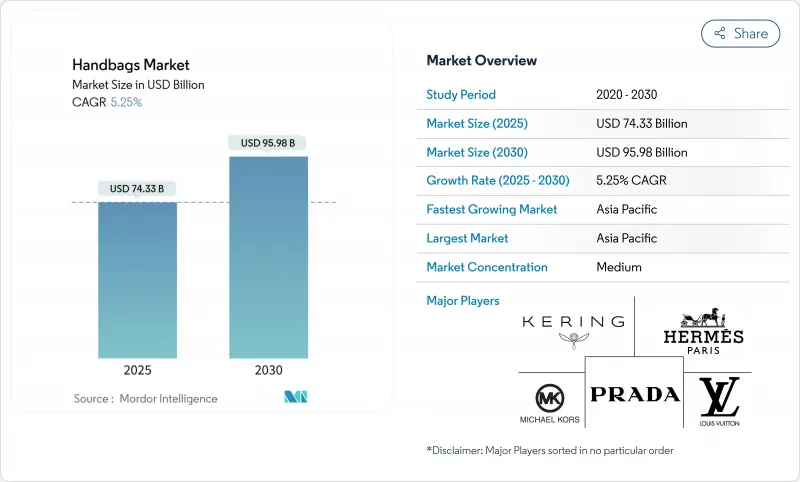
|
市場調査レポート
商品コード
1850373
ハンドバッグ:市場シェア分析、産業動向、統計、成長予測(2025年~2030年)Handbags - Market Share Analysis, Industry Trends & Statistics, Growth Forecasts (2025 - 2030) |
||||||
カスタマイズ可能
適宜更新あり
|
|||||||
| ハンドバッグ:市場シェア分析、産業動向、統計、成長予測(2025年~2030年) |
|
出版日: 2025年06月27日
発行: Mordor Intelligence
ページ情報: 英文 120 Pages
納期: 2~3営業日
|
概要
ハンドバッグ市場の2025年の市場規模は743億3,000万米ドル、2030年には959億8,000万米ドルに達すると予測され、2025-2030年のCAGRは5.25%です。

都市化が進み、女性の購買力が高まり、心の満足のために高級品を購入する傾向が強まっています。アジア太平洋地域が市場の成長を牽引しており、中でも中国は、その幅広い高級品消費者の嗜好から、重要な役割を果たしています。さらに、この地域の強いソーシャルコマース文化が市場をさらに押し上げています。トートバッグは依然として最も人気のある商品だが、仕事にもレジャーにも柔軟に対応できるデザインが消費者に好まれるようになり、バケット型バッグの人気が高まっています。デジタル技術の活用はブランドの流通チャネル拡大に役立っているが、独占販売戦略は依然として成功を収めています。さらに、欧州連合(EU)のデジタル・プロダクト・パスポートのような新たな持続可能性規制は、ブランドに対し、トレーサビリティのある素材を採用し、これらの基準に準拠するために循環型デザインに注力するよう促しています。LVMHのような企業は、特にルイ・ヴィトンの成功を通じて、垂直統合と複数ブランド間の協力から利益を得ています。
世界のハンドバッグ市場の動向と洞察
海外旅行とレジャー旅行の増加
海外旅行やレジャー旅行の人気の高まりは、ハンドバッグ、特に旅行に適したスタイリッシュなハンドバッグの需要を大きく押し上げています。世界旅行ツーリズム協議会(WTTC)によると、2024年の旅行ツーリズム部門の世界経済への貢献は10%、10兆9,000億米ドルに達します。WTTCの予測では、2035年までに観光産業は世界経済に16兆5,000億米ドルを投入し、世界GDPの11.5%を占めることになります。旅行規制の緩和や格安航空会社の利用可能性に支えられたこのような観光客の増加は、消費者が週末の旅行や休暇のためにハンドバッグを含む荷物や革製品に投資することを促しています。旅行者のニーズに応えるため、ブランドは革新的な商品を発表しています。例えば、Dagne Doverは、Petra Convertible Toteを発売しました。これは、パッド入りのラップトップコンパートメント、トロリースリーブ、複数の整理ポケットを備えた、洗練されたハイブリッドトートバックパックで、特に旅行と仕事を両立させるプロフェッショナルのために設計されています。
女性の社会進出の増加
女性の社会進出に伴い、スタイリッシュで機能的なハンドバッグへの需要が高まっています。女性たちは今、ノートパソコンや書類、身の回り品などの必需品を持ち運びながら、仕事着を引き立てるバッグを求めています。世界銀行によると、2024年には世界の女性の労働力率は40.2%に達するといいます。構造化されたトートバッグ、サッチェル、ラップトップ対応のクロスボディバッグなど、オフィスに適したハンドバッグは、実用性とファッション性を兼ね備えているため、人気が高まっています。このようなニーズに応えるため、各ブランドは、整理整頓や利便性を高めるために、複数のコンパートメントなどの機能を備えたバッグをデザインしています。例えば、マイケル・コースは2024年に「ジェットセット・トラベル・ラージ・ロゴ・トート」を発売しました。このような変化は、ハンドバッグがもはや単なるファッションステートメントではなく、現代の働く女性にとって、スタイルと機能性をバランスよく備え、日々のニーズに応える必要不可欠なツールとなっていることを示しています。
偽造品の存在
偽造品の存在は、ハンドバッグ市場にとって依然として大きな課題です。高品質の"スーパーフェイク"の台頭は、高級ブランドの評判を落としており、経験豊かなコレクターでさえ、正規品との見分けに苦労することがあります。例えば、2024年9月20日、米国デラウェア州ウィルミントンの税関・国境警備局職員は、15万1,431米ドル相当の偽造高級ハンドバッグを押収しました。この貨物は中国からデラウェア州ニューアークの住所に向けられたもので、シャネル、ゴヤール、グッチ、エルメス、ロエベ、ルイ・ヴィトンなどの高級ブランド名を偽った26個のハンドバッグが入っていました。若い消費者の多くは、こうしたレプリカを社会的ステータスを得るための手頃な方法と考え、ますます購入するようになっています。この問題に対処するため、高級ブランドはNFCタグやブロックチェーンベースの証明書などの先進技術を採用し、顧客が購入品の真正性を迅速に確認できるようにしています。偽造品のリスクについて消費者を教育し、標準化された認証方法を導入することは、ブランドの信頼を守り、ハンドバッグ市場の長期的な価値を確保するための重要なステップになりつつあります。
セグメント分析
2024年のハンドバッグ市場では、トートバッグがその実用性と多用途性により41.25%の大きなシェアを占めました。これらのバッグは、ノートパソコンや書類、その他の日常必需品を簡単に収納できるため、ハイブリッドな仕事をこなす専門家や個人の間で特に人気があります。拡張可能な内装やハイテク・ガジェット用のコンパートメントなどの機能が、その魅力をさらに高めています。一方、バケット型バッグは市場シェアこそ小さいもの、CAGR 5.46%と予測される急成長を遂げています。この成長の原動力となっているのは、カジュアルでスタイリッシュ、ストリートウェアやレジャーウェアと相性がよく、適応性の高いデザインを好む若い消費者です。都市部では、マンサー・ガブリエル(Mansur Gavriel)やプラダ(Prada)といったブランドのバケットバッグが人気を集めています。
他のハンドバッグ・スタイルも、消費者の嗜好の変化に合わせて進化しています。クラッチバッグは依然としてイブニングやフォーマルな場面によく使われるが、多機能のクロスボディバッグがこの需要の一部を占めるようになってきています。サッチェルバッグは、構築的で洗練されたデザインを好むプロフェッショナルを魅了し続けているが、ベルトバッグやモジュール式コンバーチブルバッグのような新しいスタイルは、その多用途性で注目を集めています。テクノロジーと持続可能性が市場を形成しています。トゥミやサムソナイトの2023年コレクションに見られるように、RFIDブロック・コンパートメント、ワイヤレス充電ポケット、認証用QRコードなどを備えたハンドバッグが一般的になりつつあります。サステナビリティの面では、Stella McCartneyやPangaiaといったブランドが、2024年に植物由来のレザーを使用したハンドバッグを発表しており、環境に優しい製品への需要の高まりや、より厳しい規制への対応を反映しています。
マス・セグメントは2024年のハンドバッグ市場規模の63.61%を占め、幅広い消費者にアピールするトレンディで手頃な価格のスタイルを提供しています。このセグメントのブランドは、迅速な生産サイクルと最新動向の把握に重点を置いているため、頻繁に好みを変えるZ世代の買い物客に特に人気があります。例えば、2023年には、ZARAやH&Mのようなブランドが、季節の動向にインスパイアされたハンドバッグ・コレクションを発表し、若い消費者があまりお金をかけずに様々なスタイルを試すことができるようになりました。一方、より多くの消費者が高品質の職人技と倫理的に調達された素材を求めるようになり、プレミアム・セグメントはCAGR 5.94%と予測され、成長が加速しています。コーチ(Coach)やトリーバーチ(Tory Burch)のようなプレミアム・ブランドは、限定コレクションやシリアル化されたデザインをうまく利用することで、高級感を演出し、高価格帯を正当化しています。
高級ブランドは、デジタル技術と伝統的な職人技を融合させることで、その名声と魅力を維持しています。例えば、2023年、エルメスやルイ・ヴィトンのようなブランドは、レザーが作られた特定の工房など、顧客が素材の出所を追跡できるQR対応タグ付きのハンドバッグを導入しました。この透明性は、購入者に製品の真正性を保証するだけでなく、倫理的で持続可能な慣行に対する需要の高まりにも合致しています。植物由来の革のような環境に優しい素材の使用は、高級ブランドが欧州連合(EU)のエコデザイン規制を遵守するのに役立っています。一方、中堅ブランドは、大衆製品の手頃な価格と、プレミアム・ブランドや高級ブランドの伝統的な魅力の狭間で、際立った存在感を示すという課題に直面しています。
地域分析
アジア太平洋地域は、2024年の世界売上高の43.09%を占め、2030年までCAGR 6.23%で成長すると予想されます。中国はハンドバッグの最大の生産国であり輸出国であるため、この地域で重要な役割を果たしているが、その消費者は多様です。第1級都市では、富裕層は高品質の職人技を重視し、中産階級の専門職は信頼性の高い高級品を好みます。若い消費者、特にZ世代は、持続可能で文化的なデザインに惹かれています。Xiaohongshuのようなソーシャル・コマース・プラットフォームはこの地域で人気があり、消費者が商品を発見し、同業者のレビューを入手し、迅速な購入を決定するのに役立っています。しかし、中国では価格競争が激しく、時折値下げが行われるため、ブランドは現地の需要に合わせて価格戦略や商品構成を変える必要があります。
北米は、特に高額商品購入において、依然として圧倒的な強さを誇っています。米国人旅行者は、世界の免税贅沢品消費において極めて重要な役割を果たしています。さらに、海外で頻繁に高級品を購入するアメリカの消費者は、世界の商品企画に大きな影響力を行使しています。一方、欧州は規制開発の最前線にいます。欧州連合(EU)の「デジタル・プロダクト・パスポート」構想は、2027年までに包括的なサプライチェーンの詳細を開示することをブランドに義務付け、グローバル企業に持続可能性を促しています。この規制は、世界のハンドバッグ市場に大きな影響を与えそうです。
中東・アフリカと南米は、ユニークな特徴を持つ成長市場です。湾岸協力会議(GCC)諸国では、高級品に対する強い需要があり、アフリカでは、インフラが限られているにもかかわらず、拡大する中産階級が将来の成長の可能性を示しています。南米では、変動する通貨が価格設定を難しくしているが、生産を現地化したり、柔軟な価格戦略を用いることで適応するブランドは成功できます。ソーシャルメディアの利用が増え、女性の社会進出が進み、旅行との結びつきが強くなっているこれらの地域は、世界のハンドバッグ市場への貢献度を徐々に高めています。
その他の特典:
- エクセル形式の市場予測(ME)シート
- 3ヶ月間のアナリストサポート
よくあるご質問
目次
第1章 イントロダクション
- 調査の前提条件と市場の定義
- 調査範囲
第2章 調査手法
第3章 エグゼクティブサマリー
第4章 市場情勢
- 市場概要
- 市場促進要因
- 出張やレジャー旅行の増加
- 女性の労働力参加率の上昇
- 変化するファッション動向と消費者の嗜好
- 製品イノベーションと持続可能性の動向
- ソーシャルメディアと有名人の推薦の影響
- 原材料とデザインにおける製品革新
- 市場抑制要因
- 偽造品の入手可能性
- 規制上のハードルとコンプライアンスの問題
- 材料に関する環境への懸念
- 変動する運用コスト
- 消費者行動分析
- 規制の見通し
- ポーターのファイブフォース分析
- 供給企業の交渉力
- 買い手の交渉力
- 新規参入業者の脅威
- 代替品の脅威
- 競合の程度
第5章 市場規模と成長予測
- 製品タイプ別
- サッチェル
- バケットバッグ
- クラッチ
- トートバッグ
- その他の製品タイプ
- カテゴリー別
- マス
- プレミアム
- エンドユーザー別
- 女性
- 男性
- 流通チャネル別
- オフライン小売店
- オンライン小売店
- 地域別
- 北米
- 米国
- カナダ
- メキシコ
- その他北米地域
- 欧州
- ドイツ
- 英国
- イタリア
- フランス
- スペイン
- オランダ
- ポーランド
- ベルギー
- スウェーデン
- その他欧州地域
- アジア太平洋地域
- 中国
- インド
- 日本
- オーストラリア
- インドネシア
- 韓国
- タイ
- シンガポール
- その他アジア太平洋地域
- 南米
- ブラジル
- アルゼンチン
- コロンビア
- チリ
- ペルー
- その他南米
- 中東・アフリカ
- 南アフリカ
- サウジアラビア
- アラブ首長国連邦
- ナイジェリア
- エジプト
- モロッコ
- トルコ
- その他中東・アフリカ地域
- 北米
第6章 競合情勢
- 市場集中度
- 戦略的動向
- 市場シェア分析
- 企業プロファイル
- LVMH Moet Hennessy Louis Vuitton SE
- Kering SA
- Tapestry Inc.
- Capri Holdings Ltd.
- Hermes International SA
- Chanel SA
- Prada SpA
- Burberry Group PLC
- Longchamp SAS
- Mulberry Group PLC
- Tory Burch LLC
- Braun Buffel GmbH & Co. KG
- Salvatore Ferragamo S.p.A
- PVH Corp.
- Furla SpA
- Charles & Keith Group
- Dagne Dover Inc.
- Maison Goyard
- MCM Worldwide
- VF Corporation

